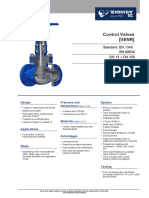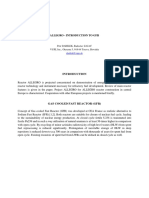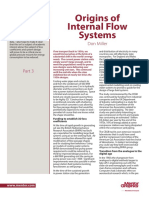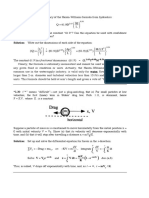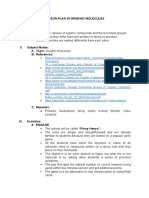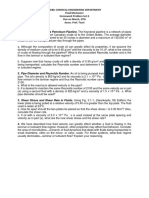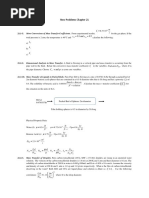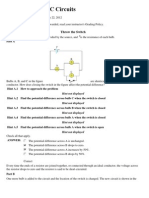Essentials of Heat Transfer: Principles, Materials, and Applications, by Massoud Kaviany
Essentials of Heat Transfer: Principles, Materials, and Applications, by Massoud Kaviany
Uploaded by
Harvin WaraichCopyright:
Available Formats
Essentials of Heat Transfer: Principles, Materials, and Applications, by Massoud Kaviany
Essentials of Heat Transfer: Principles, Materials, and Applications, by Massoud Kaviany
Uploaded by
Harvin WaraichOriginal Description:
Original Title
Copyright
Available Formats
Share this document
Did you find this document useful?
Is this content inappropriate?
Copyright:
Available Formats
Essentials of Heat Transfer: Principles, Materials, and Applications, by Massoud Kaviany
Essentials of Heat Transfer: Principles, Materials, and Applications, by Massoud Kaviany
Uploaded by
Harvin WaraichCopyright:
Available Formats
See discussions, stats, and author profiles for this publication at: https://www.researchgate.
net/publication/263761037
Essentials of Heat Transfer: Principles, Materials, and Applications, by
Massoud Kaviany
Article in Contemporary Physics · June 2013
DOI: 10.1080/00107514.2013.811292
CITATIONS READS
0 416
1 author:
Manuel Vogel
GSI Helmholtzzentrum für Schwerionenforschung
224 PUBLICATIONS 1,464 CITATIONS
SEE PROFILE
Some of the authors of this publication are also working on these related projects:
ARTEMIS @ HITRAP View project
Mainz Penning Trap View project
All content following this page was uploaded by Manuel Vogel on 07 July 2016.
The user has requested enhancement of the downloaded file.
Essentials of Heat Transfer
Massoud Kaviany
Cambridge University Press 2011
722 pages
price xxx GBP
hardcover
ISBN 9781107012400
textbook
undergraduates and advanced undergraduates
Dr. Manuel Vogel, TU Darmstadt and GSI Darmstadt, m.vogel@gsi.de
The subtitle of 'Essentials of Heat Transfer' is 'Principles, Materials and Applications'. It already gives
away the fact that this book takes a look at heat transfer as an engineering discipline rather than a
subject of pure physics. The definition of heat transfer is given as 'a result of the spatial variation of
temperature within a medium, or within adjacent media, in which energy may be stored, converted
to or from other forms of energy and work, or exchanged with the surroundings.' Looking at it as an
engineering discipline, 'heat transfer deals with the innovative use of the principles of thermal
science in solving the relevant technological problems.'
The author, Massoud Kaviany, is professor of mechanical engineering and applied physics at the
University of Michigan. He has won several awards for his teaching, and has previously written
several books on related topics, namely 'Principles of Heat Transfer in Porous Media', 'Principles of
Convective Heat Transfer', 'Heat Transfer Physics', and 'Principles of Heat Transfer' (John Wiley and
Sons, 2002). The latter contains portions of the content of the present book.
The main content here is: 'Introduction and Preliminaries', 'Energy Equation', 'Conduction',
'Radiation', 'Convection: Unbounded Fluid Streams', 'Convection: Semi-Bounded Fluid Streams',
'Convection: Bounded Fluid Streams', 'Heat Transfer in Thermal Systems' and three appendices with
'Some Thermodynamic Relations', 'Derivation of Differential-Volume Energy Equation' and 'Tables of
Thermochemical and Thermophysical Properties'. Some of the topics listed in the table of contents
are not treated within the book, but are to be found on the accompanying webpage
www.cambridge.org/kaviany under 'Ancillary materials'. They are given in a 406-page PDF document
entitled 'Kaviany Extra Chapter Content for Essential of HT.pdf'. This was done to give the present
book 'a more manageable length' in contrast to its earlier version. Also, the previously used problem-
solving engine has been replaced with the more widespread and more modern MATLAB software,
which is particularly relevant to chapter 8.
Both the treatment in the book and in the additional material is thorough and focused on technical
application. It is the author's statement that 'this introductory textbook aims to provide
undergraduate engineering students with the knowledge (principles, materials and applications) they
need to understand and analyse the heat transfer problems they are likely to encounter in practise'.
Consequently, the book gives many examples and problems from a wide range of technical
applications. Answers to the problems are given in the backmatter of the book, however without
derivation. A full solutions manual is available on the website to qualified (registered) instructors.
The text is well-written and accessible at the undergraduate level. Numerous black and white figures
illustrate the devices and processes under discussion. The book is a successful implementation of the
above-stated aims and deserves a recommendation as a textbook for undergraduate students in
engineering who take courses in thermal physics or thermal engineering.
View publication stats
You might also like
- CASE STUDY 1 - Catalytic Oxidation of SO2No ratings yetCASE STUDY 1 - Catalytic Oxidation of SO215 pages
- A Priori Phase Equilibrium Prediction From A Segment Contribution Solvation Model - Lin and SandlerNo ratings yetA Priori Phase Equilibrium Prediction From A Segment Contribution Solvation Model - Lin and Sandler15 pages
- Fundamentals of Heat and Mass Transfer 7th Edition - Bergman, Lavine, Incropera, DeWitt (1) - p0015No ratings yetFundamentals of Heat and Mass Transfer 7th Edition - Bergman, Lavine, Incropera, DeWitt (1) - p00151 page
- (Mechanical Engineering Series) Massoud Kaviany (Auth.) - Principles of Convective Heat Transfer (2001, Springer-Verlag New York) PDF100% (1)(Mechanical Engineering Series) Massoud Kaviany (Auth.) - Principles of Convective Heat Transfer (2001, Springer-Verlag New York) PDF722 pages
- CHM2123 - Organic Chemistry Laboratory Ii: FALL 2020 - SyllabusNo ratings yetCHM2123 - Organic Chemistry Laboratory Ii: FALL 2020 - Syllabus6 pages
- Sound Speed & Pipe Size Data: (For Ultrasonic Flowmeters)No ratings yetSound Speed & Pipe Size Data: (For Ultrasonic Flowmeters)50 pages
- The Kinetics of Combination Carbon Dioxide With Hydroxide IonsNo ratings yetThe Kinetics of Combination Carbon Dioxide With Hydroxide Ions9 pages
- Chemical Kinetics Simulator: An Interactive Graphical ApproachNo ratings yetChemical Kinetics Simulator: An Interactive Graphical Approach8 pages
- The Origin and Present Status of Fick's Diffusion LawNo ratings yetThe Origin and Present Status of Fick's Diffusion Law4 pages
- Generation IV Gas-Cooled Reactor ConceptsNo ratings yetGeneration IV Gas-Cooled Reactor Concepts25 pages
- Fluid Mechanics White 7th SOL Part1 Part5No ratings yetFluid Mechanics White 7th SOL Part1 Part55 pages
- Two-Phase Flow Pattern Maps For Macrochannels: October 2015No ratings yetTwo-Phase Flow Pattern Maps For Macrochannels: October 201548 pages
- ME 579: Advanced Thermodynamics: (L-T-P-S-C: 3-0-0-6-3)100% (1)ME 579: Advanced Thermodynamics: (L-T-P-S-C: 3-0-0-6-3)2 pages
- Ionic Equilibria (WS#04-Partition Coefficient)No ratings yetIonic Equilibria (WS#04-Partition Coefficient)10 pages
- Organizing Elements Int - Reader - Study - Guide PDFNo ratings yetOrganizing Elements Int - Reader - Study - Guide PDF4 pages
- Modern Physical Metallurgy and Materials Engineering: Science, Process, Applications Sixth EditionNo ratings yetModern Physical Metallurgy and Materials Engineering: Science, Process, Applications Sixth Edition4 pages
- Full Download Theory and Computation in Hydrodynamic Stability 2nd Edition W. O. Criminale PDF100% (3)Full Download Theory and Computation in Hydrodynamic Stability 2nd Edition W. O. Criminale PDF52 pages
- A Conveniet Correlation For Heat Transfer To Constant and Variable Property Study in Turbulent Pipe Flow PDFNo ratings yetA Conveniet Correlation For Heat Transfer To Constant and Variable Property Study in Turbulent Pipe Flow PDF7 pages
- Graphical Thermodynamics and Ideal Gas Power CyclesNo ratings yetGraphical Thermodynamics and Ideal Gas Power Cycles91 pages
- Fluid Mechanics White 7th SOL Part1 Part3No ratings yetFluid Mechanics White 7th SOL Part1 Part35 pages
- The Rotating Cylinder Electrode: A Review of Development100% (1)The Rotating Cylinder Electrode: A Review of Development20 pages
- The Modeling of Chemical Reactors Chapter 7No ratings yetThe Modeling of Chemical Reactors Chapter 717 pages
- A Generalized Method For Predicting The Minimum Fluidization Velocity - C. Y. WEN and Y. H. YUNo ratings yetA Generalized Method For Predicting The Minimum Fluidization Velocity - C. Y. WEN and Y. H. YU3 pages
- Physical Mathematics, by Kevin Cahill: Contemporary Physics December 2013No ratings yetPhysical Mathematics, by Kevin Cahill: Contemporary Physics December 20132 pages
- Grade 11 - Antaran Ma. Salve - Water Resources On Earth50% (2)Grade 11 - Antaran Ma. Salve - Water Resources On Earth22 pages
- Jee+main+2021 +physics+most+important+topicsNo ratings yetJee+main+2021 +physics+most+important+topics26 pages
- Prestige 24I LQ MG: Diagnostic Kit For Determination of Magnesium ConcentrationNo ratings yetPrestige 24I LQ MG: Diagnostic Kit For Determination of Magnesium Concentration2 pages
- Introduction To Nonlinear Optics and Crystal Growth Techniques ProcessNo ratings yetIntroduction To Nonlinear Optics and Crystal Growth Techniques Process9 pages
- Sodium Perchlorate 1-Hydrate (Reag. USP) For Analysis, ACSNo ratings yetSodium Perchlorate 1-Hydrate (Reag. USP) For Analysis, ACS1 page
- Construction Materials Ass2 (Yilkal.H) PDFNo ratings yetConstruction Materials Ass2 (Yilkal.H) PDF14 pages
- 28 11th Chemistry Vol.2 One Mark Study Material Tamil MediumNo ratings yet28 11th Chemistry Vol.2 One Mark Study Material Tamil Medium17 pages
- Lecture 1 Atomic and Nuclear Physics (M)No ratings yetLecture 1 Atomic and Nuclear Physics (M)81 pages
- New-Problems-Chapter-21 Convective Mass TransferNo ratings yetNew-Problems-Chapter-21 Convective Mass Transfer2 pages

































